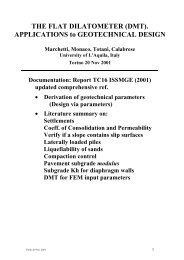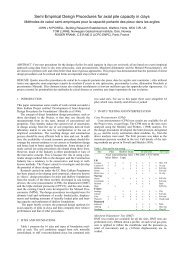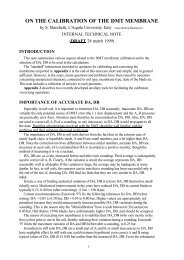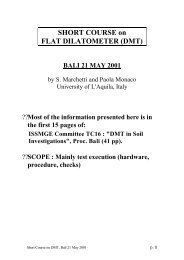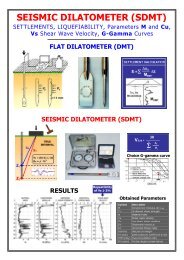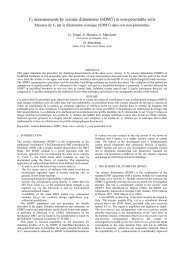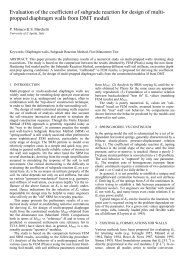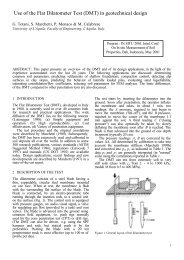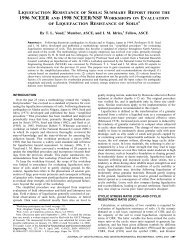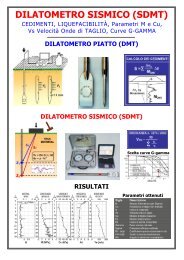The Flat Dilatometer Test (DMT) in Soil Investigations - Marchetti DMT
The Flat Dilatometer Test (DMT) in Soil Investigations - Marchetti DMT
The Flat Dilatometer Test (DMT) in Soil Investigations - Marchetti DMT
You also want an ePaper? Increase the reach of your titles
YUMPU automatically turns print PDFs into web optimized ePapers that Google loves.
NOTE: Sign of ∆A, ∆B corrections<br />
Although the actual ∆A-pressure is negative<br />
(vacuum), it simulates a positive soil pressure.<br />
Consequently it is recorded and <strong>in</strong>troduced <strong>in</strong> the p 0<br />
formula as a positive number when it is a vacuum<br />
(which is the normal case). Eq. 1 is already adjusted<br />
to take <strong>in</strong>to account that a positive ∆A is a vacuum.<br />
∆B is normally positive.<br />
NOTE: Select<strong>in</strong>g the "average" ∆A, ∆B to calculate<br />
p 0 , p 1 (for a detailed treatment of this topic see<br />
<strong>Marchetti</strong> 1999)<br />
Select<strong>in</strong>g the average ∆A, ∆B from the before/after<br />
∆A, ∆B values must be done by an experienced<br />
technician. While perform<strong>in</strong>g the average, the entity<br />
of ∆A, ∆B and their variations dur<strong>in</strong>g the sound<strong>in</strong>g<br />
will also give him an idea of the care exercised dur<strong>in</strong>g<br />
the execution.<br />
If the test has been regular (e.g. the membrane has<br />
not been over<strong>in</strong>flated, and the Eurocode 7 tolerances<br />
for ∆A, ∆B have not been exceeded), the before/after<br />
values of ∆A, ∆B are very close, so that their<br />
arithmetic average is adequate.<br />
If ∆A or ∆B vary more than 25 kPa dur<strong>in</strong>g a<br />
sound<strong>in</strong>g, the results, accord<strong>in</strong>g to the Eurocode 7<br />
(1997), should be discarded. However, if the soil is<br />
stiff, the results are not substantially <strong>in</strong>fluenced by<br />
∆A, ∆B, and us<strong>in</strong>g typical ∆A, ∆B values (e.g. 15 and<br />
40 kPa respectively) generally leads to quite<br />
acceptable results.<br />
NOTE: Comments on the 3 <strong>in</strong>termediate parameters<br />
<strong>The</strong> three <strong>in</strong>termediate parameters I D , K D , E D are<br />
derived from two field read<strong>in</strong>gs. Hence, clearly, only<br />
two of them are <strong>in</strong>dependent (the <strong>DMT</strong> is just a twoparameter<br />
test). I D , K D , E D have been <strong>in</strong>troduced<br />
because each one of them has some recognizable<br />
physical mean<strong>in</strong>g and some eng<strong>in</strong>eer<strong>in</strong>g usefulness.<br />
10. INTERMEDIATE <strong>DMT</strong> PARAMETERS<br />
10.1 MATERIAL INDEX I D (SOIL TYPE)<br />
<strong>The</strong> material <strong>in</strong>dex I D is def<strong>in</strong>ed as follows:<br />
p1<br />
− p0<br />
I D<br />
= (3)<br />
p0<br />
− u0<br />
where u 0 is the pre-<strong>in</strong>sertion <strong>in</strong> situ pore pressure.<br />
<strong>The</strong> above def<strong>in</strong>ition of I D was <strong>in</strong>troduced hav<strong>in</strong>g<br />
observed that the p 0 and p 1 profiles are systematically<br />
"close" to each other <strong>in</strong> clay and "distant" <strong>in</strong> sand.<br />
Accord<strong>in</strong>g to <strong>Marchetti</strong> (1980), the soil type can be<br />
identified as follows:<br />
clay 0.1 < I D < 0.6<br />
silt 0.6 < I D < 1.8<br />
sand 1.8 < I D < (10)<br />
In general, I D provides an expressive profile of soil<br />
type, and, <strong>in</strong> "normal" soils, a reasonable soil<br />
description. Note that I D sometimes misdescribes silt<br />
as clay and vice versa, and of course a mixture claysand<br />
would generally be described by I D as silt.<br />
When us<strong>in</strong>g I D , it should be kept <strong>in</strong> m<strong>in</strong>d that I D is<br />
not, of course, the result of a sieve analysis, but a<br />
parameter reflect<strong>in</strong>g mechanical behavior (some k<strong>in</strong>d<br />
of "rigidity <strong>in</strong>dex"). For example, if a clay for some<br />
reasons behaves "more rigidly" than most clays, such<br />
clay will be probably <strong>in</strong>terpreted by I D as silt.<br />
Indeed, if one is <strong>in</strong>terested <strong>in</strong> mechanical behavior,<br />
sometimes it could be more useful for his application<br />
a description based on a mechanical response rather<br />
than on the real gra<strong>in</strong> size distribution. If, on the<br />
other hand, the <strong>in</strong>terest is on permeability, then I D<br />
should be supplemented by the pore pressure <strong>in</strong>dex<br />
U D (see Section 11.4.4).<br />
10.2 HORIZONTAL STRESS INDEX K D<br />
<strong>The</strong> horizontal stress <strong>in</strong>dex K D is def<strong>in</strong>ed as follows:<br />
p0<br />
− u0<br />
K<br />
D<br />
= (4)<br />
σ ′<br />
v0<br />
where σ' v0 is the pre-<strong>in</strong>sertion <strong>in</strong> situ overburden stress.<br />
K D provides the basis for several soil parameter<br />
correlations and is a key result of the dilatometer test.<br />
<strong>The</strong> horizontal stress <strong>in</strong>dex K D can be regarded as<br />
K 0 amplified by the penetration. In genu<strong>in</strong>ely NC<br />
clays (no ag<strong>in</strong>g, structure, cementation) the value of<br />
K D is K D,NC ≈ 2.<br />
<strong>The</strong> K D profile is similar <strong>in</strong> shape to the OCR<br />
profile, hence generally helpful for "understand<strong>in</strong>g"<br />
the soil deposit and its stress history (<strong>Marchetti</strong> 1980,<br />
Jamiolkowski et al. 1988).<br />
10.3 DILATOMETER MODULUS E D<br />
<strong>The</strong> dilatometer modulus E D is obta<strong>in</strong>ed from p 0 and<br />
p 1 by the theory of elasticity (Gravesen 1960). For<br />
the 60 mm diameter of the membrane and the 1.1 mm<br />
displacement it is found:<br />
E D = 34.7 (p 1 - p 0 ) (5)<br />
E D <strong>in</strong> general should not be used as such, especially<br />
because it lacks <strong>in</strong>formation on stress history. E D<br />
should be used only <strong>in</strong> comb<strong>in</strong>ation with K D and I D .<br />
<strong>The</strong> symbol E D should not evoke special aff<strong>in</strong>ity<br />
with the Young's modulus E' (see Section 11.3.2).<br />
11. DERIVATION OF GEOTECHNICAL<br />
PARAMETERS<br />
11.1 STRESS HISTORY / STATE PARAMETERS<br />
11.1.1 Unit weight g and soil type<br />
A chart for determ<strong>in</strong><strong>in</strong>g the soil type and unit weight<br />
19



